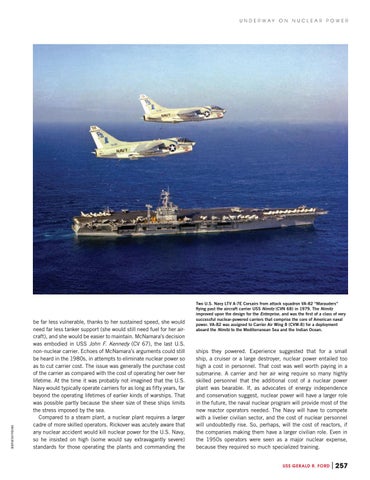DOD PHOTO BY PH2 INKS
U N D ER WAY
be far less vulnerable, thanks to her sustained speed, she would need far less tanker support (she would still need fuel for her aircraft), and she would be easier to maintain. McNamara’s decision was embodied in USS John F. Kennedy (CV 67), the last U.S. non-nuclear carrier. Echoes of McNamara’s arguments could still be heard in the 1980s, in attempts to eliminate nuclear power so as to cut carrier cost. The issue was generally the purchase cost of the carrier as compared with the cost of operating her over her lifetime. At the time it was probably not imagined that the U.S. Navy would typically operate carriers for as long as fifty years, far beyond the operating lifetimes of earlier kinds of warships. That was possible partly because the sheer size of these ships limits the stress imposed by the sea. Compared to a steam plant, a nuclear plant requires a larger cadre of more skilled operators. Rickover was acutely aware that any nuclear accident would kill nuclear power for the U.S. Navy, so he insisted on high (some would say extravagantly severe) standards for those operating the plants and commanding the
O N
N U C L E A R
P O W ER
Two U.S. Navy LTV A-7E Corsairs from attack squadron VA-82 “Marauders” flying past the aircraft carrier USS Nimitz (CVN 68) in 1979. The Nimitz improved upon the design for the Enterprise, and was the first of a class of very successful nuclear-powered carriers that comprise the core of American naval power. VA-82 was assigned to Carrier Air Wing 8 (CVW-8) for a deployment aboard the Nimitz to the Mediterranean Sea and the Indian Ocean.
ships they powered. Experience suggested that for a small ship, a cruiser or a large destroyer, nuclear power entailed too high a cost in personnel. That cost was well worth paying in a submarine. A carrier and her air wing require so many highly skilled personnel that the additional cost of a nuclear power plant was bearable. If, as advocates of energy independence and conservation suggest, nuclear power will have a larger role in the future, the naval nuclear program will provide most of the new reactor operators needed. The Navy will have to compete with a livelier civilian sector, and the cost of nuclear personnel will undoubtedly rise. So, perhaps, will the cost of reactors, if the companies making them have a larger civilian role. Even in the 1950s operators were seen as a major nuclear expense, because they required so much specialized training. USS GERALD R. FORD
257
